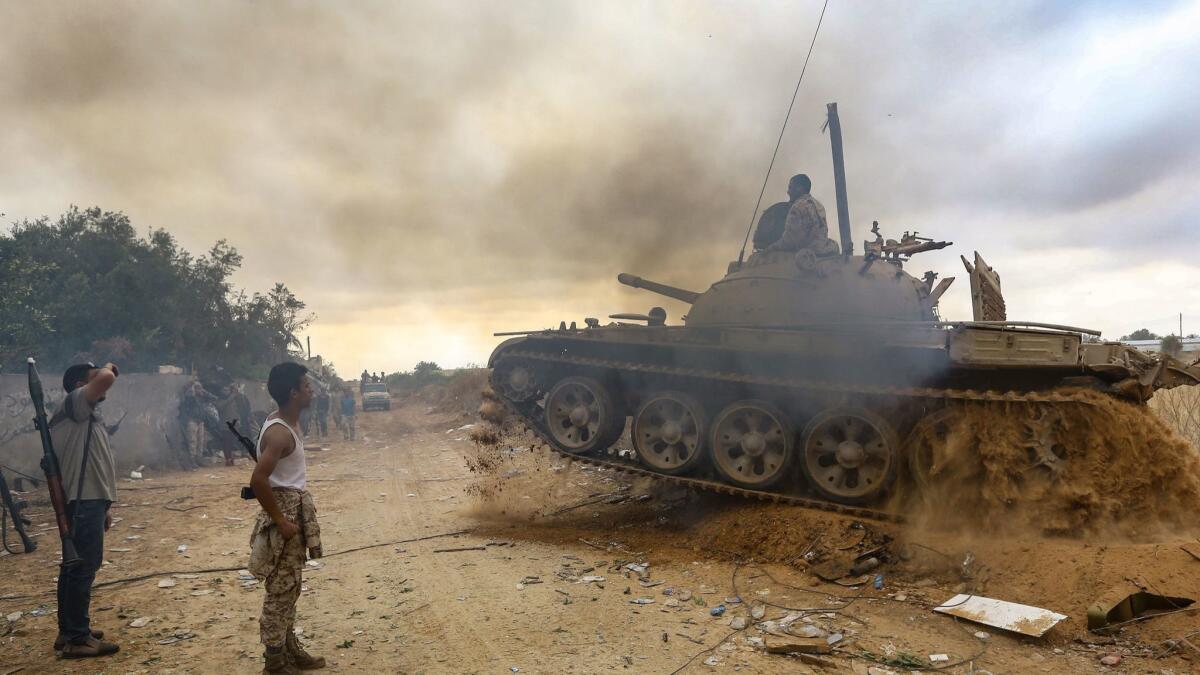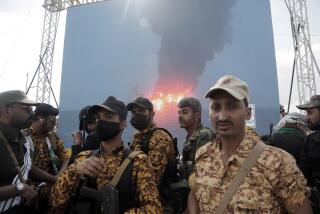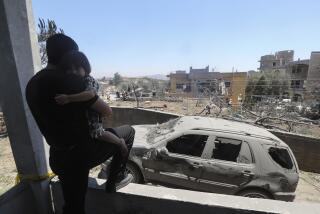Libya’s two wars: One on the battlefield and one on Facebook

Reporting from Tripoli, libya — In terms of its effect on the battlefield, a drone that fell from the skies one recent morning in an area south of the Libyan capital, Tripoli, was a nonevent. It was unarmed. When it crashed (or was shot down; it’s still unclear), it left behind no casualties.
But by the evening, the drone was the subject of thousands of impassioned Facebook duels dissecting its origin. As well, a video examining its hull became the grist for dozens of reports by satellite news broadcasters across the region.
The aftermath of the incident was just another sign that in Libya there are two concurrent wars: One involves bullets and bombs fired between the self-styled Libyan National Army and militiamen allied with the United Nations-recognized Government of National Accord (or the GNA) in Tripoli’s outskirts.
The other war is no less intense, but virtual; its ordnance is a swarm of disinformation, gruesome videos and pictures peddled by “keyboard warriors” or “digital heroes,” as Libyans sometimes dub online partisans.
In the realm of toxic social media in times of conflict, Libya stands tall. Facebook, especially, is the primary communication mode for more than two-thirds of the country, a riven nation of 6.5 million people divided in loyalties to two governments (or three, depending on how you count), an array of tribes and an ever-shifting kaleidoscope of armed factions.
“Everyone has Facebook and uses it for business,” said a Libyan social media researcher, who asked to withhold their name to avoid repercussions. “Politicians, officials, fighters… You ask them what’s your e-mail and they’ll give you their Facebook username.”
With virtually no independent media available, the rapid swarm of posts from users in and out of Libya is the main source of mass communication. But it’s also a weapon marshaled in support of developments on the physical battlefield.
“Both sides use it for propaganda,” said Oded Berkowitz, a deputy chief intelligence officer at Max Security and an expert in Libyan social media. “And with it a disinformation campaign focusing on accusing the other side of excessive collateral damage or intentional killing of civilians, and framing the enemy as serving foreign interests or having mercenaries and foreign fighters fight in their ranks.”
Libya post-Kadafi: Lurching from one crisis to another »
On April 4, Khalifa Haftar, a general in the mold of former Libyan dictator Col. Moammar Kadafi, commanded his Libyan National Army forces to move on what he called Islamist militias controlling what had become an illegitimate government holding Tripoli hostage.
Legions of his supporters mobilized online as well.
That day, they deluged Facebook with polished, graphics-laden videos sporting video of armored vehicles rumbling toward Tripoli. Pro-Haftar influencers reassured their followers that the fighters, with the help of collaborators in the capital, would enter with the least amount of collateral damage.
Others trumpeted every advance posted by the various armed groups; even some that didn’t happen. (It later earned them an admonishment that fake, so-called “Facebook control” of areas hurt their cause.)
Saudi Arabian and Emirati allies of Haftar joined the assault, especially on Twitter. Haftar receives support from both countries, along with Egypt, France and Russia.
Meanwhile, the government and factions fighting alongside mounted a counter-offensive, dubbed Operation Volcano of Anger, complete with its own Facebook page.
The day the drone descended, that page posted pictures to its more than 168,000 followers. The images depicted a white-colored fuselage sporting two Emirates flag decals and a sign saying, “Made in the UAE.”
Government supporters shared the photos as well as an activist-shot video of the drone. Soon after, the first of the pro-GNA channels, Libya Al-Ahrar, also shared the images and posted a story about the video. It was picked up by Al-Jazeera Mubasher, the live Arabic-language channel of the Qatari news network, which broadcast its own video. (Qatar and Turkey both support the GNA.)
Pro-Haftar activists shot back, pointing out that the colors on one of the flags were reversed. The War Information Division, the official page of the Libyan National Army’s operations, dismissed the story as “lies and fabrication,” and insisted that the drone belonged to the GNA and had been shot down by Haftar’s forces the previous day. Saudi and Emirati news channels ran with that version of the story, using it as proof of Turkey and Qatar’s perfidy.
All that happened within an hour of the original post.
Facebook removes fake accounts tied to Indian political parties, Pakistan’s military »
Aside from the speed with which such stories spread, Facebook also reflects the chaotic, occasionally surreal brand of fighting seen in Libya.
Clips of gunmen doing doughnuts with captured tanks; SAM anti-aircraft trucks firing their missiles horizontally at ground targets; a video featuring visibly intoxicated pro-Haftar fighters lobbing mortars in a civilian neighborhood; images of Haitham Tajouri, a one-time bus driver turned millionaire commander of a powerful faction dressed in Versace and Dolce & Gabbana for a trip to the battlefield: Such happenings are standard fare on Libyan social media.
And very little of what happens on the battlefield remains hidden.
When a presumably secret shipment of Turkish armored carriers arrived in Tripoli’s harbor earlier this month (with Turkish army trainers in tow), images of the vehicles rolling off the ship appeared on Facebook. Their counterparts in the Libyan National Army feted the arrival of their own Jordanian-made armored vehicles.
Also on display is the casual viciousness with which gunmen treat their enemies. A recent investigation by the Arabic-language arm of the British Broadcasting Corp. uncovered pictures and videos taken by members of Haftar’s elite Al-Saiqa Brigade posing with the mutilated corpses of their Islamist adversaries.
A Facebook spokesperson said the company was “working hard to fight abuse on our services, particularly in conflict zones like Libya where Facebook can be used to incite violence and spread hate, terrorist and extremist content and graphic material.”
The spokesperson added that the company has “global safety and security teams,” including some 15,000 content reviewers.
“These content review teams are located in over 20 sites around the world - including sites in North Africa - working round the clock to review reported content.”
The toxicity is reflected on Libyan television channels. One example is Mohammad Emtallel, a newscaster aligned with Haftar who in April spent part of his show cheering and laughing to video of rockets smashing into Tripoli’s residential neighborhoods.
Then there is Noman Benotman. A former Haftar supporter, he’s now a turbo-tongued defender of the Tripoli government, with a Trumpian knack for choosing derisive nicknames.
He has hundreds of thousands of followers on Facebook, and is also a regular on Libya Al-Ahrar, where he engages in hours-long exegeses railing against Haftar and his allies. (One of his marathon sessions was recently interrupted when hackers hijacked the broadcast with the defiant-looking visage of the general.
“What [Benotman] is doing is coming up with terms that are sowing hate and division, and you’re having people here from this side responding to him in kind,” said Mohammad Eljarh, co-founder of Libya Outlook for Research and Consulting, a think tank based in Libya’s east, where Haftar is dominant. “It’s creating really problematic dynamics. People say they’re watching them for fun, but this is not something to be laughing about.”
Both Haftar and the Tripoli government have hired Washington, D.C., lobbyists to further their cause in Washington’s power circles and attract favorable media coverage, according to foreign agent registration documents released by the U.S. Justice Department.
Still, the main objective of the various posts was less about forging a narrative than creating confusion, said the Libyan social media researcher who asked to remain anonymous.
The drone story is an example of that. By day’s end, there was already a Photoshopped image of a Turkish flag online instead of that of the Emirates on the fuselage, and multiple explanations as to how it had crashed south of Tripoli.
“It’s not about discrediting, but putting as many versions out there as possible so people will get overwhelmed,” said the Libyan researcher. “If you create enough confusion, no one knows what to believe.”











